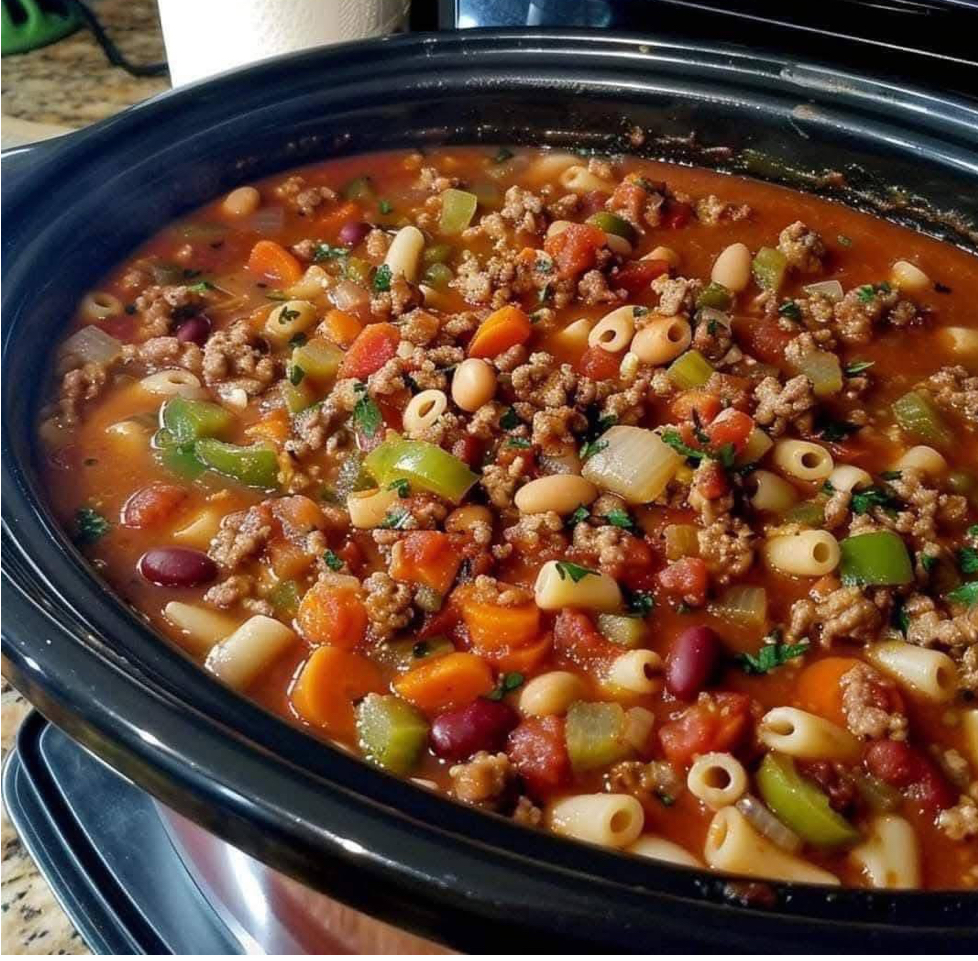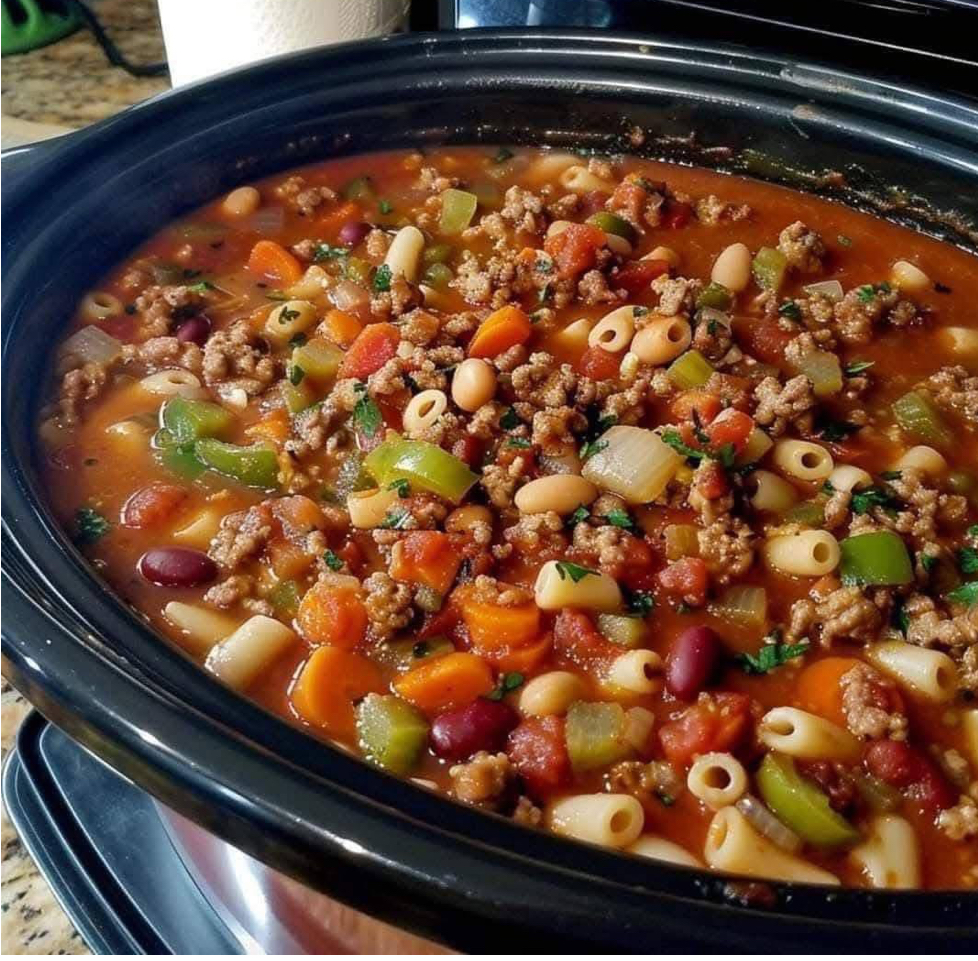
Introduction
Pasta Fagioli, also known as “pasta and beans,” is a comforting Italian classic that brings together simple pantry ingredients to create a filling and nutritious meal. Traditionally considered a peasant dish, it has evolved into a favorite across households worldwide due to its wholesome flavors, versatility, and ability to feed a crowd.
This soup is not only budget-friendly but also customizable, making it perfect for any season. Whether you’re looking to warm up on a chilly evening or need a one-pot dish for a gathering, this recipe is your answer!
Ingredients
Serves: 6-8
Prep Time: 15 minutes
Cook Time: 45 minutes
- Proteins & Beans:
- 1 lb (450g) ground beef or Italian sausage
- 1 cup red kidney beans (canned or cooked)
- 1 cup cannellini beans (canned or cooked)
- Vegetables:
- 1 medium onion, diced
- 3 garlic cloves, minced
- 2 carrots, sliced
- 2 celery stalks, diced
- 1 green bell pepper, chopped
- 1 can (14 oz) diced tomatoes
- 1 can (8 oz) tomato sauce
- Liquids & Seasonings:
- 4 cups beef broth or vegetable stock
- 1 teaspoon dried basil
- 1 teaspoon dried oregano
- 1 teaspoon thyme
- Salt and black pepper to taste
- 1 bay leaf
- Pasta:
- 1 cup ditalini or small pasta
- Optional Garnishes:
- Fresh parsley, chopped
- Grated Parmesan cheese
Preparation Steps
- Prepare the Ingredients:
Wash and dice all the vegetables. Rinse canned beans if using. Measure out the spices and broth for easy access during cooking. - Cook the Meat:
In a large pot or slow cooker, brown the ground beef or sausage over medium heat. Break it into crumbles, ensuring it’s cooked through. Drain excess fat if necessary. - Sauté the Vegetables:
Add diced onion, garlic, carrots, celery, and bell pepper to the pot. Sauté for 5-7 minutes until vegetables are slightly tender. - Combine the Base:
Pour in the diced tomatoes, tomato sauce, beef broth, and seasonings (basil, oregano, thyme, and bay leaf). Stir well to combine. - Simmer:
Bring the mixture to a gentle boil, then reduce the heat to low. Cover and let it simmer for 25-30 minutes to develop flavors. - Cook the Pasta:
Add ditalini or your choice of pasta to the soup and let it cook for an additional 10-12 minutes until al dente. - Add Beans:
Gently stir in the kidney and cannellini beans during the last 5 minutes of cooking to heat them through without breaking them apart. - Garnish and Serve:
Remove the bay leaf, then ladle the soup into bowls. Garnish with fresh parsley and grated Parmesan cheese for added flavor
Methods for Preparing Pasta Fagioli
There are several ways to prepare Pasta Fagioli depending on your time, tools, and cooking preferences. Below are the key methods, including traditional, stovetop, slow cooker, and Instant Pot techniques.
Traditional Method
This method reflects how Pasta Fagioli was originally made—slowly simmered over low heat for maximum flavor development.
- Cook the Beans:
If using dried beans, soak them overnight and cook them until tender. Reserve the cooking liquid for extra flavor. - Sauté Aromatics:
In a large pot, sauté onions, garlic, celery, and carrots in olive oil. - Simmer:
Add the beans, tomatoes, broth, and seasonings. Allow it to simmer for an hour or more to meld flavors. - Add Pasta:
Cook pasta separately or in the soup during the last 10-12 minutes of simmering. - Finish:
Drizzle with olive oil or garnish with fresh herbs before serving.
Stovetop Method (Quick and Easy)
For those with less time, this modern approach simplifies preparation.
- Brown the Meat:
In a large pot, cook ground meat or sausage until browned. Remove excess grease. - Add Vegetables:
Sauté onions, garlic, celery, and carrots in the same pot. - Combine Ingredients:
Stir in beans, tomatoes, broth, and seasonings. Bring to a boil, then reduce to a simmer. - Cook Pasta:
Add pasta directly to the pot and cook until al dente, about 10 minutes. - Serve:
Remove from heat, garnish, and enjoy immediately.
Slow Cooker Method (Set It and Forget It)
Perfect for busy days, this method requires minimal hands-on time.
- Prepare Ingredients:
Brown the meat and sauté the vegetables on the stovetop if desired, or add them raw for convenience. - Load the Cooker:
Add beans, tomatoes, broth, seasonings, and browned meat (if using) into the slow cooker. - Cook:
Set on low for 6-8 hours or high for 3-4 hours. - Add Pasta:
In the last 30 minutes, stir in pasta and let it cook until tender. Alternatively, cook pasta separately and add it before serving. - Finish and Serve:
Stir well, garnish, and serve.
Instant Pot Method (Quick Yet Flavorful)
For an even faster preparation, use a pressure cooker.
- Sauté Mode:
Use the sauté function to brown the meat and soften the vegetables. - Combine Ingredients:
Add beans, tomatoes, broth, and seasonings. Stir to combine. - Cook:
Lock the lid, set the Instant Pot to high pressure, and cook for 8 minutes. - Quick Release:
Perform a quick release, then switch back to sauté mode. - Add Pasta:
Stir in the pasta and cook for 5-7 minutes until al dente. - Serve:
Ladle into bowls and garnish.
Pro Tips for Success
- Avoid Overcooked Pasta: If making a large batch for leftovers, cook the pasta separately and add it to individual servings to prevent it from becoming mushy.
- Boost Flavor: Use high-quality broth and fresh herbs for the best taste.
- Make It Creamy: Add a splash of heavy cream or Parmesan cheese for a creamy twist.
- Customization: Add leafy greens like spinach or kale for added nutrition.
Each method provides a delicious bowl of Pasta Fagioli, ensuring you can adapt the process to your schedule and taste preferences.
Nutritional Information (Per Serving)
- Calories: 310
- Protein: 18g
- Carbohydrates: 40g
- Fiber: 10g
- Fat: 8g
- Cholesterol: 35mg
- Sodium: 750mg
History
Pasta Fagioli originated in Italy as a humble dish designed to make the most of accessible and affordable ingredients. Its roots lie in the southern Italian regions, where beans and pasta were staple foods. Over time, it became a symbol of resourcefulness, embodying the spirit of Italian cooking—simple, hearty, and rich in flavor.
In North America, this dish gained popularity through Italian immigrants, becoming a beloved comfort food often served in family-style restaurants.
Pasta Fagioli, also known as Pasta e Fagioliin Italian, translates to “pasta and beans.” This dish has humble beginnings, originating in Italy as a staple of peasant cuisine. In ancient times, particularly during the Roman Empire, beans were a vital protein source for those who couldn’t afford meat, and wheat pasta was a readily available carbohydrate. Together, they formed a hearty, nourishing meal that sustained families through hard times.
Regional Roots
Pasta Fagioli’s recipe varied greatly depending on the region of Italy and the resources available. In northern Italy, the dish often featured more butter or cream, reflecting the dairy-rich cuisine of the area. In southern Italy, olive oil and tomatoes dominated, influenced by the Mediterranean diet. The type of pasta also differed, with shapes like ditalini or broken spaghetti commonly used.
Evolution Over Time
Originally, Pasta Fagioli was prepared without meat, making it a budget-friendly meal accessible to all social classes. Over time, as prosperity grew and trade expanded, additional ingredients like pancetta, sausage, or ground meat were added for flavor. Herbs like basil, oregano, and thyme became signature seasonings, reflecting Italy’s rich agricultural heritage.
A Dish for the People
Pasta Fagioli epitomized the Italian principle of la cucina povera—”the cuisine of the poor.” This concept focused on creating wholesome, delicious meals with simple, inexpensive ingredients. The dish’s adaptability allowed families to use whatever beans or pasta they had on hand, minimizing waste.
Global Popularity
Italian immigrants introduced Pasta Fagioli to the United States and other parts of the world in the late 19th and early 20th centuries. It quickly became a comfort food staple in Italian-American communities, eventually making its way into popular culture. Today, it is often featured in Italian restaurants, family kitchens, and even on the menus of global food chains.
Pasta Fagioli remains a symbol of resourcefulness, community, and the power of simple, flavorful cooking to bring people together. It’s a reminder that some of the most beloved dishes come from the humblest origins.
Benefits
- Nutritious: Packed with protein, fiber, and essential vitamins, this dish promotes healthy digestion and energy.
- Versatile: Can be made vegetarian by omitting the meat or tailored with gluten-free pasta for dietary needs.
- Budget-Friendly: Uses inexpensive ingredients while yielding generous portions.
- One-Pot Convenience: Simplifies cooking and cleanup
Pasta Fagioli is more than just a comforting, hearty meal—it’s a dish packed with health benefits and nutritional value. Its combination of simple, wholesome ingredients offers a variety of advantages for your body and overall well-being.
1. High Nutritional Value
- Rich in Protein: The beans in Pasta Fagioli are an excellent plant-based protein source, essential for muscle growth, tissue repair, and energy. Adding meat, like ground beef or sausage, can further boost the protein content.
- Complex Carbohydrates: The pasta provides slow-digesting carbs, keeping you full for longer and stabilizing blood sugar levels.
- Vitamins and Minerals: Ingredients like tomatoes, carrots, celery, and onions are rich in vitamins A, C, and K, as well as potassium and magnesium.
2. Heart-Healthy
- Lowers Cholesterol: Beans are high in soluble fiber, which helps reduce LDL (bad cholesterol) levels and promotes heart health.
- Supports Healthy Blood Pressure:The potassium in beans and vegetables helps balance sodium levels, reducing blood pressure risks.
3. Aids Digestion
- Fiber-Rich: Beans, vegetables, and whole-grain pasta (if used) contribute to digestive health by promoting regular bowel movements and preventing constipation.
- Gut Health: Fiber also supports a healthy gut microbiome, which is essential for immune function and nutrient absorption.
4. Budget-Friendly and Accessible
- The core ingredients—beans, pasta, and vegetables—are inexpensive and widely available, making it a cost-effective meal option for families.
5. Great for Weight Management
- Low in Calories: When prepared with lean meat or no meat, Pasta Fagioli is relatively low in calories while still being filling.
- Satiety: The combination of protein, fiber, and carbohydrates keeps you full, reducing the likelihood of unhealthy snacking.
6. Customizable for Dietary Needs
- Vegan-Friendly: By skipping meat and using vegetable broth, Pasta Fagioli becomes a delicious vegan dish.
- Gluten-Free Option: Swap regular pasta for gluten-free pasta to accommodate dietary restrictions.
- Dairy-Free Option: The dish doesn’t require dairy, but cheese toppings can be omitted for a fully dairy-free meal.
7. Boosts Immunity
- The tomatoes and vegetables in the soup are packed with antioxidants like vitamin C and lycopene, which help strengthen the immune system and protect against chronic diseas
8. Comforting and Versatile
- Emotional Well-Being: Warm, flavorful soups like Pasta Fagioli are known to comfort the soul and reduce stress after a long day.
- Meal Prep Friendly: This dish can be made in large batches, stored, and reheated, making it ideal for busy schedules.
Pasta Fagioli combines affordability, nutrition, and comfort in one pot. It’s a versatile dish that supports your health while delivering incredible flavor. Whether you’re looking to feed a family on a budget, manage your weight, or simply enjoy a hearty, satisfying meal, Pasta Fagioli ticks all the boxes.
Conclusion
Pasta Fagioli is more than just a soup—it’s a hearty embrace in a bowl. Perfect for feeding a crowd or prepping for a week of meals, it brings family and friends together around the table. With its rich history, nourishing qualities, and customizable nature, it’s no wonder Pasta Fagioli has remained a timeless favorite.
So grab a ladle, serve up this Italian gem, and share the love with your own twist
